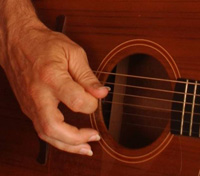 When you consider the song structure you want to write your song in, you are really deciding on the architecture of the song. Just like a blueprint lays out the rooms in your home as they relate to each other, so does the song structure determine how the sections of your song are laid out. Rather than looking at the history of how the different structures and forms that songs take came into being, we are going to list and describe the ones that are most often used.
When you consider the song structure you want to write your song in, you are really deciding on the architecture of the song. Just like a blueprint lays out the rooms in your home as they relate to each other, so does the song structure determine how the sections of your song are laid out. Rather than looking at the history of how the different structures and forms that songs take came into being, we are going to list and describe the ones that are most often used.
The Verse Form is the simplest of all the song structures. It is the most like poetry in that it simply expresses its message, Verse after Verse. This form is almost exclusively used in older Folk Music. Prevalent in the songs sung by Pete Seeger, Joan Baez, Peter, Paul, and Mary, and Gordon Lightfoot, among thousands, this is the storytellers form.
The Verse Form with Refrain is a Folk song with a hunger for a Chorus. Unfortunately, these wanna be choruses never develop into full-fledged choruses, but seem to function as a one line repetitive refrain at the end of each Verse. A perfect example of a Verse Form with Refrain is Bob Dylan’s Blowin’ in the Wind. The Verses tell the story and at the end of each Verse is the refrain, “the answer my friend, is blowin’ in the wind, the answer is blowin’ in the wind.” This is too short to be a Chorus, but it works like a Chorus to pull the listener’s ear through to the next Verse.
The Verse and Chorus form is the one that is most predominantly used today throughout most all genres of music. It contains two or three Verse sections with a Chorus section following each Verse. The Chorus is roughly the same size as the Verse, but almost always has the same words every Chorus while the Verse has different words every time as it tells the story. The Verse and Chorus are usually written to entirely different but harmonically related chord progressions and have different melodies as well.
A variant to the Verse and Chorus form is the Verse, Chorus, with Bridge form. Everything is the same as the Verse and Chorus form, except that where the third Verse would have been, there is a Bridge. The Bridge only happens once in the song. It can range from a couple of lines, to the same size as a Verse, to up to double the size of the Verse. It is almost always written to an entirely unique harmonic progression and talks about subject matter not previously talked about in the song. Most often the Bridge resolves to the final Chorus, but on occasion it can resolve to a final Verse, which leads to the final Chorus.
Another variation on the Verse and Chorus form is the Verse, Chorus with Pre-Chorus form. This form is derived from early Country music which had an A section and a B section to the Verses, with the B section driving into the Chorus. Pop music picked up on this technique, and now the Pre-Chorus is a very often used part of contemporary songwriting. The Pre-chorus is not quite a Chorus, but gives a little lift into the Chorus. It is written to a different chord progression than the Verse or the Chorus. The lyrics in the Pre-chorus can either repeat as do the Chorus lyrics, or they can be different every time like the Verse lyrics.
The final variation on Verse and Chorus form is the Verse, Chorus, Bridge, Pre-Chorus form. This is just a combination of the previous two forms, with a Pre-Chorus introducing the Chorus, and a Bridge replacing a third Verse. In this variation, in order to prevent the song from being too long, the Pre-Chorus that would have followed the Bridge is omitted, and instead goes straight to the Chorus.
That brings us to 32 Bar Song Form. This was actually the principle song form of the songs from the 20s through the 50s, excluding Folk Music, Country, and Bluegrass. This was the form of Gershwin, Cole Porter, Irving Berlin, Harold Arlen, Rogers and Hart, among many others. This form traditionally has a short and unique section with an intro type quality that precedes what we think of as the song. That section is actually called the verse, and for better or worse is rarely performed anymore. What we think of as the song, is the Chorus and is 32 bars long and is usually divided into 8 bar segments with segment 1, 2, and 4 having the same melody and chords but with unique lyrics, while segment 3 has totally different chords, melody, and words.
There is something very surprising about this form. While for the most part, we think of this as a somewhat antiquated form and not often used today except in musical theater, is was the predominant form used by the Beatles through the formative years of their writing. I find this interesting because many scholars believe the form makes the song, and yet with the Beatles, their songs sounded nothing like Gershwin, or the music of the forties and fifties. The Beatles’ sound was very fresh and distinctly contemporary in their time. It consistently amazes me that young artists who want to have a major impact on the music industry like the Beatles did, never expand their horizons to consider song forms that their competition aren’t currently using.
Song structure is a powerful component of each and every song you’ll write. It is a highly worthwhile process to go through the different song structures, finding musical examples of each and every one, and attempt to write your own song using each form. You might surprise yourself.
If you’re looking to truly master your songwriting skills, My Songwriting Coach is available for private instruction, classes, and workshops.
Meet David Randle
has written 8 post in this blog.
David is a lifelong guitarist and songwriter, with a highly developed knack for producing and arranging. He spends a great deal of time mentoring and coaching aspiring music artists and songwriters to rise to the pinnacle of their abilities. Music definitely is a language we all can understand. Connect with David on Google+.








 Follow me on Twitter
Follow me on Twitter 
